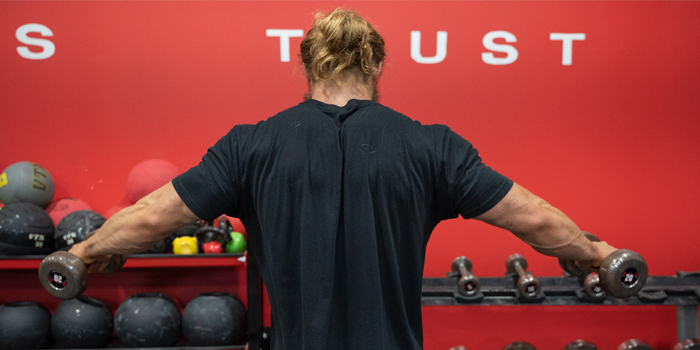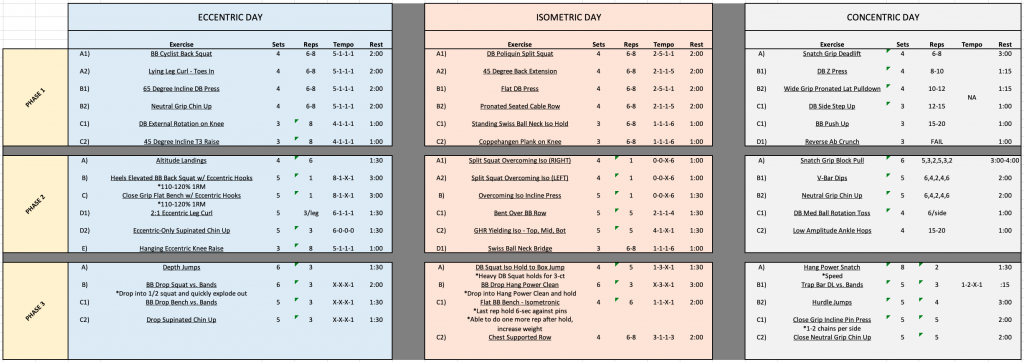
I want to preface this article by saying I DID NOT come up with this system. I am simply passing on what I have learned over the last 3-4 months and how I’ve implemented it myself.
I started looking into this system earlier last spring after listening to Ben Prentiss (from Prentiss Hockey Performance) talk on the Mike and Brooker Show podcast. I had already been thinking about improving my training philosophy and was looking at emphasizing the different contractions because of how they contribute to sporting performance. The only problem I ran into was that I did not know how to incorporate all of them together effectively.
After I heard Ben talk about how he trained his athletes, it all made sense. Fast forward a month, I was flipping through some of my notes of previous books I had read, and low and behold, there it was! Christian Thibaudeau had written about the system in his book Theory and Application of Modern Strength and Power Methods (lesson here is to REREAD your notes or books). After researching more about the system and consulting with Ben, I hope to give you a BRIEF description of the system.
Each training day is full body and emphasizes one specific contraction.
Day 1 – Eccentric Day
Day 2 – Isometric Day
Day 3 – Concentric Day
Day 4 – Gap Day (optional)
I want to emphasize again that I did NOT develop this and that I am not an expert on it. I am still learning and refining how I implement it with my athletes. I simply want to pass on what I’ve learned and provide a basic progression with minor explanations, as well as a sample 12-week program I might write for a client. If this article catches your attention, I highly suggest buying Christian’s book or booking consultations with Ben or Christian. Both are a wealth of knowledge.
Phase 1 – Accumulation (Structural)
The primary goal of this phase is to build muscle tissue and tendon resilience. As you will see with the progression, each phase builds upon one another (the basis of periodization). This phase, being an accumulation phase, will tend to be higher in volume and/or time under tension. Therefore, here is the outline for the first phase:
Eccentric – (Super) Slow Eccentric
An eccentric muscle action of between four to eight seconds is ideal here, with longer eccentrics being done with fewer reps. This helps build tendon strength, increase the muscle’s tolerance to load, as well as lengthen the muscle fibers.
Isometric – Yielding Isometric or Long Holds
Holding a contraction at a specific joint angle can help increase the muscle's resilience at the specific angle. Maintaining the isometric in the stretch position can also be very beneficial, especially for increasing mobility of specific joints (ie. Split squat for hip flexors and ankle).
Concentric – Repetition Method, Bodybuilding Work, Sled Work
The concentric day is simply about building general physical preparedness (GPP). Depending on the athlete’s needs, they may do hypertrophy work or conditioning work with a sled.
Gap Day – Recovery, Mobility, Prehab, Bodybuilding
This day is available if needed to address specific needs that are not able to be done on the other days.
Phase 2 – Intensification (Strength)
Now that the muscles and tendons have a higher tolerance to loads, they are prepared to be subjected to higher intensity neural work. The main goal is to stress the body hard for 3-4 weeks to elicit a “supercompensation” effect during the final phase.
Eccentric – Maximal or Supramaximal Eccentrics
Eccentric hooks or accentuated eccentric methods are used in this phase. Accentuated eccentric basically refers to emphasizing the eccentric action by making it more difficult than the concentric action (ex. 2:1 Leg Curl exercise). By performing very heavy eccentrics, it is reinforcing the body’s capacity to absorb force, as well as recruiting a higher percentage of fast-twitch fibers. As Christian Thibaudeau mentions in his book, “You can’t produce what you can’t absorb." Essentially, this phase prepares the body to produce more force in the next phase.
Isometric – Overcoming Isometrics
Pushing or pulling against pins or a rack is a very fast way of increasing strength at specific joint angles emphasized by recruiting a large number of motor units. Although it is a very effective method, it is very specific to the angle worked, plus or minus 15 degrees. Therefore, it is important to work at three different angles or positions per movement. Each exertion is done for four to six seconds, one to two reps per set.
Concentric – Max Effort or Olympic Lifts from Blocks
Think of this day as the basic Westside Barbell Max Effort Day. NO TEMPO. Just lift heavy with proper technique. Olympic lifts from blocks would also be used on this day if the athlete has sufficient strength and needs more speed or speed strength. The goal of this day is to produce maximal dynamic force.
Gap Day – Repetition Method, Recovery
Since the first three days are very demanding on the nervous system, this Gap Day should be either used as a recovery day or low-stress bodybuilding work. If you have an athlete that requires more muscle, this would be the day to include machine exercises. I emphasize machines because they are less demanding on the nervous system than barbells and dumbbells. Essentially, get a massive pump without building too much fatigue or soreness that can hinder recovery for next week.
Phase 3 – Transfer/Realization (Speed)
Phase 2 allowed the body to accommodate and produce large amounts of force. The goal of Phase 3 now is to take that increased force production and make the athlete produce it more quickly (aka more powerful). This is the phase with the most leeway (in my opinion) and the methods used depend entirely on what the athlete needs most. For example, a younger, weaker athlete may still benefit by using heavy lifting, especially on the concentric day, whereas a more experienced and stronger athlete would be more suited to speed work. Complex training is highly recommended in this phase to help the athlete transfer strength increases to power. Although the methods may differ, the principles remain the same.
Eccentric Day – Overspeed Eccentrics
Using accommodating resistance in the form of bands and incorporating depth jump variations are typically used on this day. Bands provide overspeed eccentric because the bands essentially pull the weight down, thus increasing the total energy of the system. The fast eccentric, sometimes even a drop, creates a rapid stretch and elicits a more powerful stretch reflex, which causes an increase in force production. The same thing applies to depth jumps or Shock Training, as developed by Verkhoshansky. Normally, depth jumps are frowned upon due to potentially being too dangerous if the athlete can’t absorb the forces. The beauty of this system’s progression is that the athlete had just gone through a three- to four-week period of maximal or supra-maximal loading eccentrics, meaning they CAN tolerate the forces. Again, the methods of each phase build upon each other leading up to this final phase.
Isometric Day – Functional Isometrics, Overcoming Isometrics for Speed
Ben Prentiss uses Functional Isometrics, or Isometronics, in this phase. Christian Thibaudeau wrote about Over-Coming Isometrics for Speed, which involves producing maximal force in the least amount of time. Essentially, a coach has some freedom when it comes to the Isometric Day in the last phase. As always, it depends on what the athlete needs most. For example, I used a contrast of overcoming isometrics with explosive jumps this summer with a group of athletes before they were heading to their respective camps.
Concentric Day – Heavy Partials, Plyometrics, Olympic Lift from Hang or Floor, Sprints
Similar to the Isometric Day, there can be a variety of methods used. If speed is the priority, Olympic lifts from the hang position would be a good option. If the athlete isn’t strong enough, heavy partial movements could be beneficial. Resisted or unresisted accelerations and sprints, plyometrics, and medicine ball work can all be used. Evaluate the athlete’s sport and individual needs to determine the appropriate training.
Gap Day – Repetition Method, Recovery
Same as Phase 2. With the seasons following this phase, the goal is to increase the volume of sport practice, which means decreasing the volume of weight training to begin decreasing cumulative fatigue. Of course, if the athlete is young and is recovering well, a small amount of low-stress machine work would not hurt.
Warning: I would not recommend some of these techniques on young novice athletes due to their level of stress (ex. maximal/supra-maximal eccentrics). For younger athletes, I would recommend staying with slow eccentrics and yielding isometrics until they’ve developed enough eccentric and isometric strength and perfected technique.
Sample 12-Week Program
Now that you understand the general concepts and progression of the Omni-Contraction System, I will lay out a very basic 12-week program that would be used for an intermediate/advanced athlete. As you will see, the emphasis in the last phase is on speed, but being an intermediate athlete, he would still benefit from some basic strength work. Also, I did not include the Gap Day because there is too much variation for that day. It also depends a lot on how the athlete feels that specific day and if an additional training day would be beneficial.

Recap
Even though an athlete may not be ready to do maximal eccentrics or overcoming isometrics, I think the main takeaway from the article is that we, as strength coaches, need to start thinking about how emphasizing the different muscle contractions can be beneficial to our athletes. Don’t forget, sports include all three contractions, not just concentric; therefore, lifting maximal concentric weights all the time without increasing eccentric or isometric strength will limit our athletes’ ability to produce force on the playing field, not to mention leave them more susceptible to injury.
If you’re interested in knowing more about the system or how to use it, get in touch with Ben or Christian, or even feel free to email or DM me and I can help any way I can.
References
- Dietz, C., & Peterson, B. (2012). Triphasic training: A systematic approach to elite speed and explosive strength performance. Bye Dietz Sport Enterprise.
- Thibaudeau, C., & Schwartz, T. (2007). Theory and application of modern strength and power methods. F Lepine Pub.
Max Daigle is currently finishing his undergrad at McGill University in BSc. Physiology, with a Minor in Kinesiology. He played NCAA Division 1 hockey at the University of Vermont before transferring to McGill, where he played two seasons. Max is the assistant strength coach at Axxeleration Performance Center, under the mentorship of Mark Lambert (Head Strength Coach Tampa Bay Lightning NHL) and Sebastien Lagrange. Axxeleration Performance Center is a private gym just outside Montreal, Quebec, that works primarily with hockey players.










